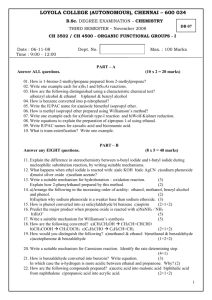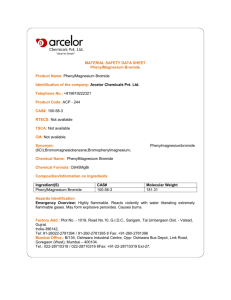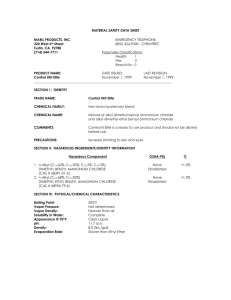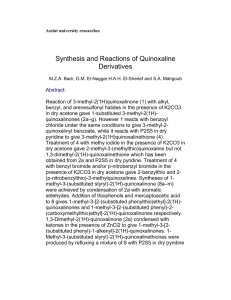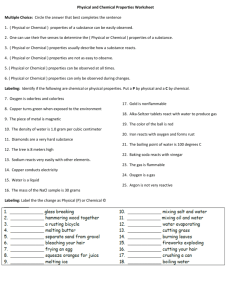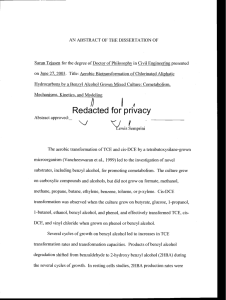Chemistry Test 1 - Saraswati Classes
advertisement
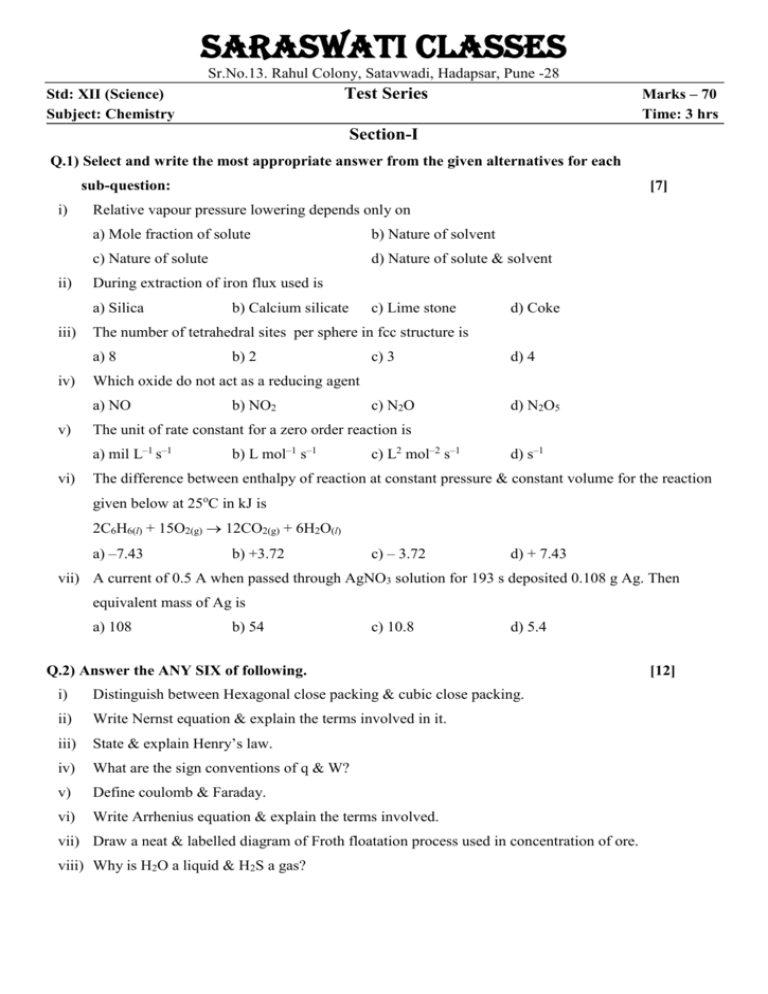
Saraswati Classes Sr.No.13. Rahul Colony, Satavwadi, Hadapsar, Pune -28 Marks – 70 Time: 3 hrs Test Series Std: XII (Science) Subject: Chemistry Section-I Q.1) Select and write the most appropriate answer from the given alternatives for each sub-question: i) ii) Relative vapour pressure lowering depends only on a) Mole fraction of solute b) Nature of solvent c) Nature of solute d) Nature of solute & solvent During extraction of iron flux used is a) Silica iii) d) Coke b) 2 c) 3 d) 4 b) NO2 c) N2O d) N2O5 The unit of rate constant for a zero order reaction is a) mil L–1 s–1 vi) c) Lime stone Which oxide do not act as a reducing agent a) NO v) b) Calcium silicate The number of tetrahedral sites per sphere in fcc structure is a) 8 iv) [7] b) L mol–1 s–1 c) L2 mol–2 s–1 d) s–1 The difference between enthalpy of reaction at constant pressure & constant volume for the reaction given below at 25oC in kJ is 2C6H6(l) + 15O2(g) 12CO2(g) + 6H2O(l) a) –7.43 b) +3.72 c) – 3.72 d) + 7.43 vii) A current of 0.5 A when passed through AgNO3 solution for 193 s deposited 0.108 g Ag. Then equivalent mass of Ag is a) 108 b) 54 c) 10.8 d) 5.4 Q.2) Answer the ANY SIX of following. i) Distinguish between Hexagonal close packing & cubic close packing. ii) Write Nernst equation & explain the terms involved in it. iii) State & explain Henry’s law. iv) What are the sign conventions of q & W? v) Define coulomb & Faraday. vi) Write Arrhenius equation & explain the terms involved. vii) Draw a neat & labelled diagram of Froth floatation process used in concentration of ore. viii) Why is H2O a liquid & H2S a gas? [12] Q.3) Answer the ANY THREE of following. [9] i) Explain the anomalous behaviour of oxygen. ii) Calculate molarity & molality of sulphuric acid solution of density 1.198 g cm–3 containing 27% by mass of sulphuric acid (Molar mass of H2SO4 = 98 g mol–1). iii) Given the following equations & Ho values at 25oC, (a) 2H3BO3(aq) B2O3(s) + 3 H2O(l), Ho = + 14.4 kJ, (b) H3BO3(aq) HBO2(aq) + H2O(l), Ho = – 0.02 kJ, (c) H2B4O7(s) 2 B2O3(s) + H2O(l), Ho = + 17.3 kJ, calculate Ho for the following reaction, iv) H2B4O7(s) + H2O(l) 4 HBO2(aq). In a first order reaction A B, 60% of the given sample of compound decomposes in 45 minutes. What is the half-life of the reaction? Q.4) Answer the ANY ONE of following. i) [7] a) An atom crystallizes in fcc crystal lattice and has a density of 10 g cm–3 with unit cell edge length of 100 pm. Calculate number of atoms present in 1 g of crystal. b) Derive the relationship between G & Stotal. c) Write the names & formulae of two ores of copper. ii) a) Explain the trends in the following properties with reference to group 17: (1) Atomic radii & ionic radii (2) Density (3) Ionization enthalpy (4) Electronegativity b) Calculate Eocell, Ecell & G for the following reaction at 25oC. Mg(s) + Sn2+ (0.03M) Mg2+(0.04M) + Sn(s). EoMg = –2.37V & EoSn = –0.14V. Is the reaction spontaneous? c) State van’t Hoff-Avogadro’s law. Section-II Q.5) Select and write the most appropriate answer from the given alternatives for each sub-question: i) The species with an atom in +6 oxidation state is a) MnO4– ii) iv) c) NiF6– d) CrO2Cl2 b) 2, 6 c) 4, 4 d) 6, 4 It is difficult to break C–Cl bond in CH2 = CH – Cl due to a) Hyper conjugation b) Resonance c) Electronic effect d) Inductive effect Thermosetting polymer is a) Nylon-6 v) b) Cr(CN)6– Primary & secondary valency of platinum in the complex [Pt(en)2Cl2] are a) 4, 6 iii) [7] b) Bakelite c) Nylon-6,6 d) SBR b) Ethyl propionate c) Methyl salicylate d) Methyl benzoate Iodex contain a) Methyl acetate vi) Benzyl phenyl ether reacts with hydrogen bromide to give a) Benzyl bromide & phenol b) Benzyl alcohol & bromobenzene c) Benzyl bromide & bromobenzene d) Benzyl alcohol & phenol vii) Identify the compound ‘B’ in the following series of reactions. Na/alcohol Ethanenitrile → a) Ethyl chloride Q.6) i) NaNO2 /dil.HCl A→ B b) Ethyl amine c) Ethyl alcohol d) Propyl alcohol Answer the ANY SIX of following. Predict the products in following reactions. 1.Br ,P 2 (a) CH3–CH2–CH2–COOH 2.aq.NH 3 [12] (b) Acetone Zn−Hg/Conc.HCl ∆ ii) Distinguish between lanthanoides & actinoides. iii) Explain the optical activity of lactic acid. iv) How is phenol prepared from benzene sulphonic acid? v) Give a chemical test to distinguish between pentan-2-one & pentan-3-one. vi) How is nitroethane prepared from (a) ethyl bromide (b) acetaldoxime. vii) What are essential and non-essential amino acids? Give one example for each type. viii) What is effective atomic number (EAN)? Find EAN of Fe in [Fe(CN)6] 4–. Q.7) Answer the ANY THREE of following. i) What are transition elements? Give the general characteristics of transition elements. [9] ii) On the basis of VBT explain the nature of bonding in [Co(C2O4)3]3– ion. iii) Discuss the SN1 mechanism of alkaline hydrolysis of t-butyl bromide with energy profile diagram. iv) How are following conversions brought about? (a) But-2-en-1-al to But-2-en-1-ol (b) Acetaldehyde to Isopropyl alcohol (c) Phenol to anisole Q.8) i) Answer the ANY ONE of following. [7] a) C4H8 (A) reacts with HBr to give C4H9Br (B) as only one product. ‘B’ reacts with magnesium metal in presence of dry ether to give ‘C’. The compound ‘C’ reacts with dry ice to give a salt which on acidification gives ‘D’. The compound ‘B’ reacts with potassium cyanide and the product on acidification gives ‘D’. Write chemical equations for all reactions & identify the compounds A B, C & D. b) Draw the structures of D-Eruthrose & D-Ribose in Fischer projection. c) How is nylon-6 prepared? ii) a) How will you convert aniline into (1) Phenol, (2) 4-Bromoaniline, (3) Sulpanilic acid? b) What are sterols? How are they classified? c) What is tincture of iodine? What is its use? Best Of Luck

